Imagine a gorgeous garden bursting with cute juicy pumpkins and other fall gifts: flowers, fruits, noiseless leaf-fall.
Not enough space? Read how to grow pumpkins even in small back-yards.

Arranging growing pumpkins
Thinking about a rich fall harvest, we keep in mind delicious pumpkins of different sizes. Many people give up growing a pumpkin in a small garden cause it takes up much space cause its vines can reach more than 20 feet.
The most efficient way is to grow pumpkins vertically on a fence or a trellis securely. You need just 2×2 square foot garden space, time, pumpkin seeds, and imagination.
With our easy tips, you may succeed in gardening without extra expenses.
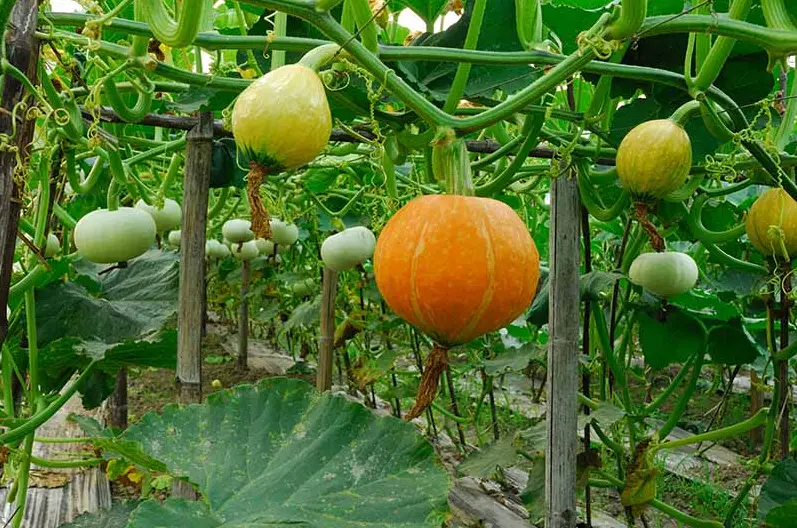
Can pumpkins be grown vertically?
A vertical garden is the way of growing plants in a vertical or semi-vertical way, usually in a frame, trellis or as a fence. You can arrange it as a green wall, or as a beautifully shaped decoration. Pumpkin vines love to climb to make them a perfect choice for vertical gardens using less space.
Pumpkins like some indoor plants are vining plants that can easily be trained to climb a trellis of any shape.
Growing pumpkins vertically be ready to provide plants with full sun, enough nutrients, and good water, for happy growth upward on their trellises.
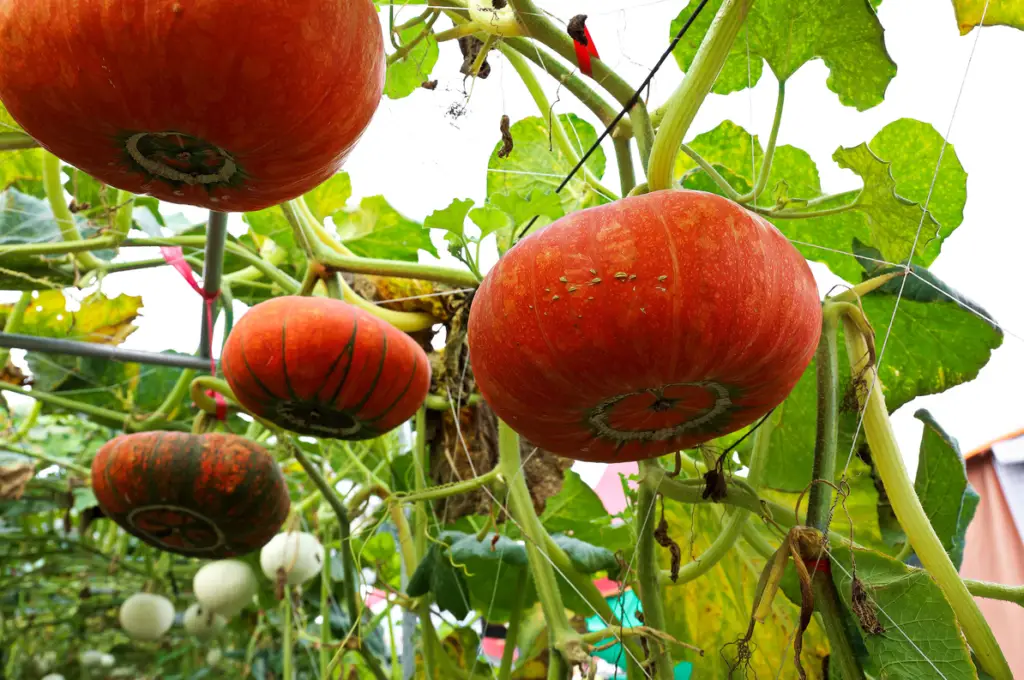
Best species for growing pumpkins vertically
Planning growing pumpkins vertically, take the best species. Not all types can be successfully grown vertically.
Among pumpkin variety, don’t choose Jarrahdale and Mammoth Gold, they are big and heavy pumpkins. Most vertical frames won’t be able to carry their weight.
To grow them, find enough space for larger pumpkins, as their vines can take a pretty large area. A local community garden space is a suitable place for growing larger pumpkins, where they can spread out on the ground.
To grow your own pumpkins vertically, medium-sized pumpkins such as Babby Boo, Jack Be Little, or Sugar Pie suit the best. These species require limited space and give petit pumpkins.
In some stores, you can also find the Harvest Mix which includes three types of small pumpkin seeds of Goolingan, Hooligan, and Bumpkin.
But no matter what you choose, with proper care, attention and appropriate conditions your pumpkin plant will thrive grown vertically.
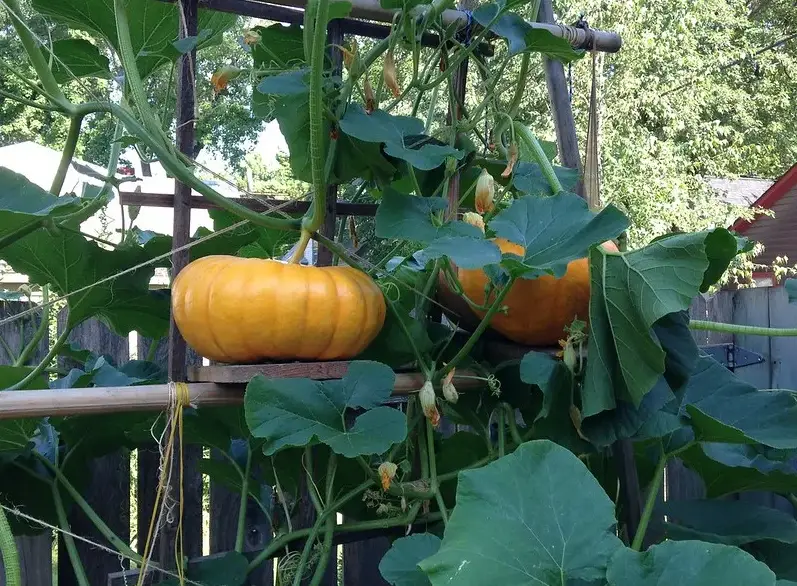
Best conditions for growing pumpkins
To plant pumpkins, you’d better choose the time between early mid-spring to early summer. But be sure the last frost does not harm the greenery.
Pick up a place with enough sunbeam in the growing season as pumpkin requires at least 4-6 hours of sun a day.
No matter whether you start vertical gardens or not, add 2-3 inches of compost to the area where you will plant the seeds.
Water deeply at least once a week, but the exact amount depends on rock type and weather conditions. Be sure that the soil stays moist and prevents your pumpkins from withering or wilting.
Talking about fertilizing, once 7-10 days with a well-balanced organic water-soluble fertilizer like compost tea or a fish emulsion will serve the best.
Once your pumpkin plants and produces flowers, it is best to hand pollinate. At first, male flowers will send signals to the plant that there are pollinators nearby and due to that, female flowers will be produced.
Female flowers have baby pumpkins right at the base or right behind the flower on the stem. This shows that pollination was successful, and now it is time to wait until fruit becomes bigger and produces pumpkin vines.
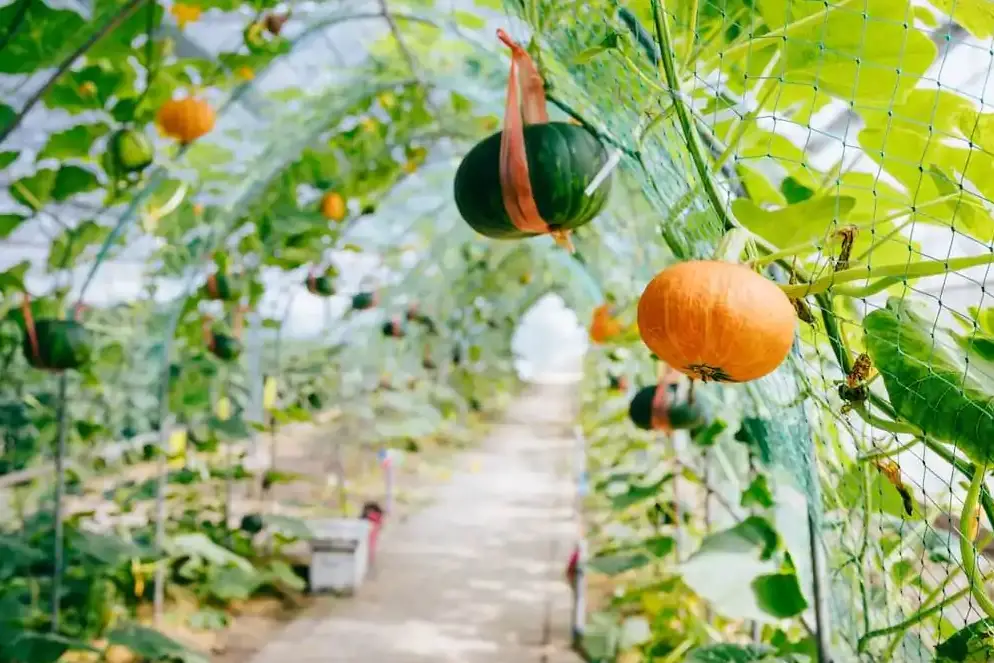
What types of vertical structures exist?
A vertical garden gives us an excellent option to save space by gathering the rich harvest. It may also serve as decoration.
You can grow your plants as a part of a green fence, or a wall. There are also freestanding trellises. They come in a variety of shapes and sizes, up to everybody’s preferences.
Why not create or buy a trellis out of a frame with a lattice in the middle? Fix any shape to fit the design of your garden with grown pumpkins.
Varieties of trellises
There are two popular shapes to grow pumpkins vertically. A traditional trellis is a vertical rectangular frame lattice with a rectangular basement to keep it stable. You can attach it to a wall of the house or a fence to shape an easy green hedge.
Another popular shape is the A-frame trellis. It is a two-rectangular frame with lattices fixed together and joined at the top to shape a triangle. Such a structure is firm and perfect to keep fruits and vegetables and supports medium-sized pumpkins.

What trellises work the best?
Most trellises are made of wood, metal, and plastic. Metal frames seem the best, as they are durable and strong enough to support the weight of any garden plant.
Some models look great in a garden, keeping pumpkin plants. Have a look at a decorative metal gazebo that seems a decorative obelisk.
A cattle panel trellis is also firm and affordable. It is 16 feet long and 50 inches tall and can be used as an arch trellis between a raised bed. You can find it in any local farm store.
Can I buy a Trellis to grow pumpkins vertically?
Different types of trellises are available in stores. You may select the one up to your preferences. Be sure it fits all your requirements and space.
Find the one that is ideal for growing pumpkins vertically. Different arches, arbors, net trellises look rather attractive and keep pumpkins vertically safely.

Can I make my own trellis?
To create your own trellis, you need extra time and some materials.
Collect wooden posts, string or wire, fixings, and tools. You may need to get to a hardware store in advance to purchase other supplies.
Then set up a frame for your design. And do not forget to fix it to the ground. The bottom should be fixed into stakes, so it will stay in the ground.
You also need wires, or heavy garden twine to support climbing vines. Cut the stripes to gently tie the pumpkin vines to the trellis. Be aware they might be easily relocated while the pumpkins grow for better air circulation.
Take your time, and you’ll be surprised by how satisfying it is to watch the homemade trellis. And who knows, maybe it is the way to get a green thumb!
Can pumpkin grow up a trellis?
Definitely yes. A pumpkin vine can easily be trained to grow up a trellis, or you can build a tower to support the pumpkin vines.
Small pumpkin varieties such as Baby boo or Hooligan can work well in trellis using small space. The bigger pumpkin will require some help. Choose a trellis that has an A-structure for medium and large pumpkins, as a heavy fruit required extra support in planting.
How do you grow a small pumpkin vertically?
For growing pumpkins vertically, I use a trellis in an established garden site. Place the retaining walls north of my yard to prevent shaded areas for pumpkins. Then I locate a sturdy post in each planting area and attach a four-inch piece of mesh.
After I gently tie vine trellises with garden twine. When I first started growing pumpkins vertically in my backyard, I used an old pantyhose to tie plants to the trellis. Just put small pumpkins or another plant inside the hose and just wrap the other end around the pumpkin and tie that end to the trellis.
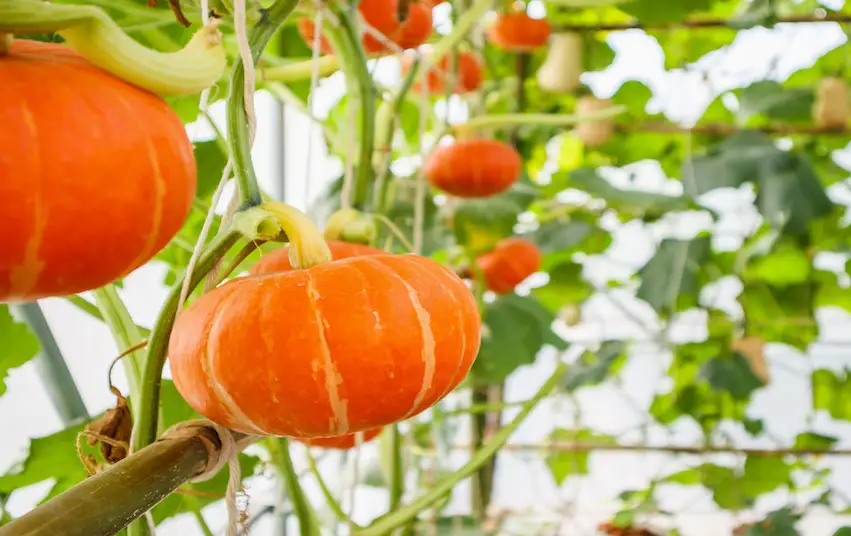
When should you trellis a pumpkin?
Growing pumpkins takes a long, about 90-120 days, depending on the species. Small pumpkins may even be ready in 80 days.
Plant the pumpkin seeds 1 inch deep, cover them with soil and supply good watering. Once your pumpkin sprout, you should keep the weeds away from the pumpkin. Being watered properly to grow, true leaves will appear and reach about 6-8 inches long.
As the pumpkins grow and tendrils appear, be sure to wrap them around the trellis to hold them in a place for vertical gardening.
Should I train pumpkin vines?
No, you shouldn’t train pumpkins. Luckily, vines can easily catch a trellis and give a shape to any frame with pumpkins. But the pumpkin plants will be more secure if you gently wrap their tendrils onto the trellis.
Then planted fruit begins spurring new growth in that direction, and you can direct other stems onto the same path to get the exact desired figure in gardening.
Be sure your pumpkins will try growing vertically, even in a small space. Vines are strong enough to climb every surface they meet and can hardly attach twigs without extra support while the plant grows.
To know more about vertical gardening, check out the article – You can grow pumpkins vertically – give these methods a try!
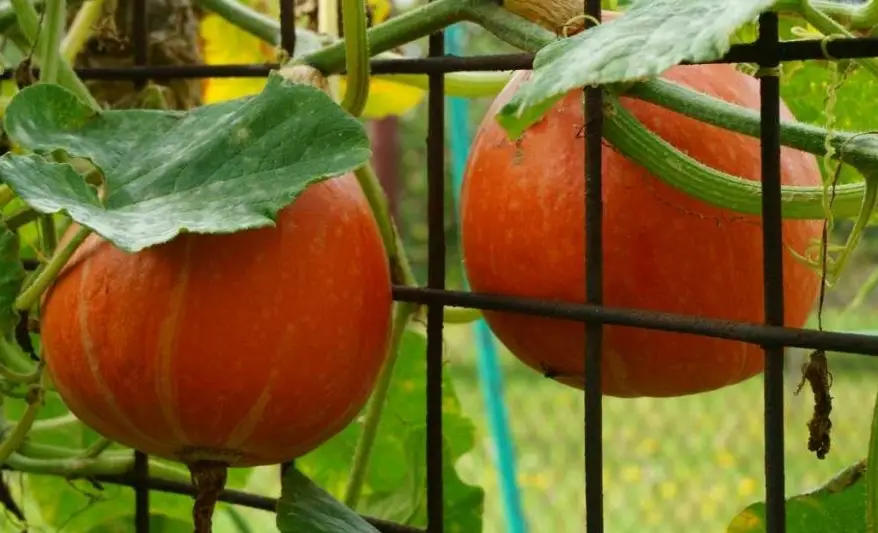
How to make a pumpkin tower?
Growing pumpkins vertically is quite easy. All you need is to get the frame for the pumpkin vines to grab onto, seeds, bedrock, water, fertilizers, sunlight, and a little bit of space and time. Try this! And your plants will make a brilliant pumpkin tower.
To make a pumpkin tower trellis of 2 feet in diameter, take about 4 feet of strong metal wire fencing. I prepare a 6 feet height fence. Then attach it to the ground and surround the pumpkin tower with soil. Pack the territory loosely as you need to insert seeds around the perimeter and the pumpkins will grow better with loose soil.
Give rich watering to produce many pumpkin vines emerging from the ground. After they appear, desirably order the vines to the tower. It may be useful to cut several windows in the fence, so you can easily reach inside to retrieve or test pumpkins.
To sum up
Easy tips help to grow pumpkins vertically without additional support. Just try vertical gardening, as it produces a bountiful harvest of delicious fruits.
And did you know that vertical growing prevents pumpkins from pests such as squash bugs and diseases such as powdery mildew, while your leafy orange friend takes its sweet time growing?
Wish to relax in your garden last summer months among flowers, juicy vegetables, and pumpkins growing on a trellis? Follow these steps and you succeed!
You may be interested in – Can yellow leaves turn green again and how can you fix it?
- Why Are There Still No Tomatoes in My Tomato Plants? Let’s Fix the Issue! - July 13, 2023
- Water Propagation White Stuff on Roots: Everything You Should Know! - July 11, 2023
- String of Dolphins Drying Up: Solved! - July 11, 2023
